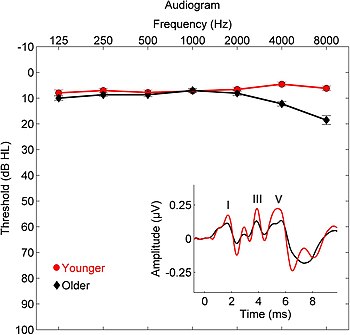The absolute threshold of hearing (ATH), also known as the absolute hearing threshold or auditory threshold, is the minimum sound level of a pure tone that an average human ear with normal hearing can hear with no other sound present. The absolute threshold relates to the sound that can just be heard by the organism.[1][2] The absolute threshold is not a discrete point and is therefore classed as the point at which a sound elicits a response a specified percentage of the time.[1]
The threshold of hearing is generally reported in reference to the RMS sound pressure of 20 micropascals, i.e. 0 dB SPL, corresponding to a sound intensity of 0.98 pW/m2 at 1 atmosphere and 25 °C.[3] It is approximately the quietest sound a young human with undamaged hearing can detect at 1 kHz.[4] The threshold of hearing is frequency-dependent and it has been shown that the ear's sensitivity is best at frequencies between 2 kHz and 5 kHz,[5] where the threshold reaches as low as −9 dB SPL.[6][7][8]

- ^ a b Durrant J D., Lovrinic J H. 1984. Bases of Hearing Sciences. Second Edition. United States of America: Williams & Wilkins
- ^ Gelfand S A., 2004. Hearing an Introduction to Psychological and Physiological Acoustics. Fourth edition. United States of America: Marcel Dekker
- ^ RMS sound pressure can be converted to plane wave sound intensity using , where ρ is the density of air and is the speed of sound
- ^ Gelfand, S A., 1990. Hearing: An introduction to psychological and physiological acoustics. 2nd edition. New York and Basel: Marcel Dekker, Inc.
- ^ Johnson, Keith (2015). Acoustic and Auditory Phonetics (third ed.). Wiley-Blackwell.
- ^ Jones, Pete R (November 20, 2014). "What's the quietest sound a human can hear?" (PDF). University College London. Archived from the original (PDF) on 2016-03-24. Retrieved 2016-03-16.
On the other hand, you can also see in Figure 1 that our hearing is slightly more sensitive to frequencies just above 1 kHz, where thresholds can be as low as −9 dBSPL!
- ^ Feilding, Charles. "Lecture 007 Hearing II". College of Santa Fe Auditory Theory. Archived from the original on 2016-05-07. Retrieved 2016-03-17.
The peak sensitivities shown in this figure are equivalent to a sound pressure amplitude in the sound wave of 10 μPa or: about -6 dB(SPL). Note that this is for monaural listening to a sound presented at the front of the listener. For sounds presented on the listening side of the head there is a rise in peak sensitivity of about 6 dB [−12 dB SPL] due to the increase in pressure caused by reflection from the head.
- ^ Montgomery, Christopher. "24/192 Music Downloads ...and why they make no sense". xiph.org. Archived from the original on 2016-03-14. Retrieved 2016-03-17.
The very quietest perceptible sound is about -8dbSPL


